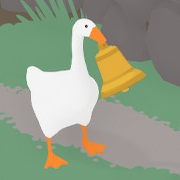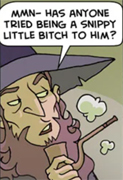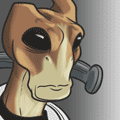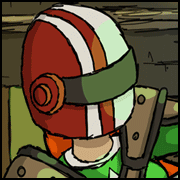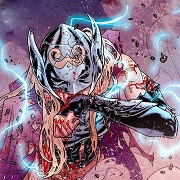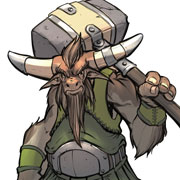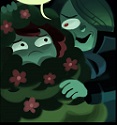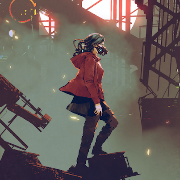|
Libertad! posted:How complicated are Burning Wheel's rules systems overall? Very. I can't speak for the later iterations of the game - I believe Mouse Guard at least shaved off a lot of the chaff - but BW itself is a complex system of interlocking parts. It's also very easy to 'play wrong', apparently, since that's what BW-likers tell me if I mention I didn't particularly enjoy the system when I tried it. I would never try to introduce new players to the hobby with it - go for DW or Fate.
|
|
|
|

|
| # ? Jun 2, 2024 09:47 |
|
Libertad! posted:Fortunately I own copies of FATE, Dungeon World, and The One Ring. I haven't gotten around to reading the former two in-depth, but I think I'll check out DW because I got Monsterhearts recommended to me as Doing It Right. Yeah, Burning Wheel is a complex machine. I certainly don't recommend you base your game on it; I just brought it up as a mechanical example. *World is pretty simple: Roll 2d6+Bonus; on a 7-9 you do okay, on a 10+ you do great, and on a 6- you screw it up. Likewise, White Wolf's system is, at core, a simple dicepool: add up the dots you have in the relevant attribute and skill, roll that many dice, count up the number that landed 8+. You can teach that in a minute, even if a dicepool has a weird probability spread. Fate is kind of simple but you have weird dice and four different action types and stuff; it can be hard to get new players to grasp the difference between creating advantages and overcoming obstacles.
|
|
|
|
One big hurdle I'm not sure how to get over is art. I feel like releasing a product with no art in it is doing it wrong, but I have no money with which to commission art. I've thought about public domain type stuff, but I tend to have really specific aesthetics/elements in mind that are really difficult to meet. I'd rather choke on a live trout than ask somebody to make me art for free, not that I know any artists well enough to ask in the first place 
|
|
|
|
Tollymain posted:One big hurdle I'm not sure how to get over is art. I feel like releasing a product with no art in it is doing it wrong, but I have no money with which to commission art. I've thought about public domain type stuff, but I tend to have really specific aesthetics/elements in mind that are really difficult to meet. I'd rather choke on a live trout than ask somebody to make me art for free, not that I know any artists well enough to ask in the first place This is one of the (many) similar hurdles for me. It's making me finally buckle down and get back into drawing as well as learn computer art, though I'd want to release a product sooner than 'a few years from now, maybe never.' If it's mostly finished from the writing angle, maybe you can do a kickstarter for an art budget?
|
|
|
|
I'm terrified of the thought of trying to do a Kickstarter.
|
|
|
|
I've been doing a lot of thinking about art myself and I'd definitely agree that the Creative Commons and public domain stuff is a but of a mixed bag. If you don't have a large operating budget, you might consider a profit sharing model. Obviously this is easier if you have a relationship with an artist already, but of offering a solid percent of the net revenue might persuade someone who is just starting out, especially if you feel comfortable giving them money up front in the future. It's probably wise to keep your art to a minimum, especially for early and smaller projects. Just a cover, and maybe one piece per chapter is probably enough, at least until you have some positive cash flow and can afford more. Other aspects of production, like an excellent layout will go a long distance in the meanwhile.
|
|
|
|
|
Tollymain posted:I'm terrified of the thought of trying to do a Kickstarter. You could totally offer some up and coming artist some great "exposure" for their work!
|
|
|
|
Thanks for the system recommendations, folks. I'm going to look into Dungeon World and Monsterhearts for the time being. However, due to my weekly Roll20 game I'm pretty much generating Pathfinder material for Arcana High automatically, so it's likely we might have a 2-system game (sort of like what Green Ronin did with their Freeport Companions). In related news... this is less system and more an aesthetic choice, but lately in comics there seems to be a popular trend regarding rear end in a top hat superheroes. Transplanting superhero tropes and themes onto a D&Desque requires alterations, as is to be expected, but many of my ideas are predicated upon a certain style of heroism which doesn't seem all that common anymore in modern comics. Treasure-hunting isn't as important, so PCs get Upgrades which replicate the effects of magic items. You get experience for defeating enemies, but you gain just as much for "quest-related" and role-playing things like resolving conflicts related to your character's background or simply acting like heroes. Taking personal risks to save civilians from casualties, successfully thwarting bad guys' plots, those are intended to be major sources of experience beyond going out and punching people while under the mask. Even in my own Arcana High Pathfinder session the PCs' relics responsible for transformation had to be activated by an act of genuine altruism (saving people from a burning building). If I were to design the adventure for a broader audience, I'd have to ask myself "but what if the PCs don't, or aren't really good people?" This is more of a sense of personal taste, but is the possibility of players who want to be "superheroes" without the "hero" moniker a potential issue? Like how likely is it that a substantial portion of potential consumers are going to be thrown off by giving in-game incentives for them to "act like a Boy Scout?" I don't expect all games to replicate Superman (they are teenage wizards, after all!), but I'm not very fond of that Iron Age "barely better than the villain" vibe. And given that D&Desque fantasy gaming is strongly predicated on the "gold and glory by slaying monsters" aspect, is that going to be a larger issue? TL;DR I'm not fond of the latest crop of comics like Garth Ennis' The Boys, Ultimate Avengers, and other stuff where superheroes are little more than masked thugs brutalizing the weak and I don't want to encourage that mechanically. Libertad! fucked around with this message at 22:28 on Sep 20, 2014 |
|
|
|
I think that the way you setup the setting and the way you phrase things can have a huge impact on how people view and react to things. If you've created a world where heroism is seen as the right thing, people will be inclined to be heroic. Beyond that, you can always offer a mechanical stick to encourage certain kinds of behavior, through xp or fate points or other sorts of metagame currencies. If the game's fiction also encourages this sort of behavior and it's visible to the players, then I don't think you'll experience much push back.
|
|
|
|
|
Libertad! posted:
Stay far far away from Mark Millar. The man despises the concept of heroes.
|
|
|
|
I've decided to put my AW hack on the backburner for a bit, and I'm working on a system of my own. It's a narrative focused game, with inspiration pulled from Polaris, FAE, and Shadowguiding from Wraith: The Oblivion. It's been a bit slow going, but I'd be grateful if anyone was willing to take a look at the first section I've made, for players currently playing the Protagonist. The link is here. Most of the game's concepts should be covered in that section, but I'm interested in hearing what sort of things are unclear. Along with any other sort of feedback.
|
|
|
|
|
Tollymain posted:I'm terrified of the thought of trying to do a Kickstarter. Why? It's not like you could do worse than so many other kickstarters that have gone up. If all you need is some art, you're goal could be pretty low, and if all you're going to do is publish digitally you don't even need to worry about printing costs or shipping product. The KS thread is full of people with experience that can give you advice and feedback.
|
|
|
|
Meinberg posted:I've decided to put my AW hack on the backburner for a bit, and I'm working on a system of my own. It's a narrative focused game, with inspiration pulled from Polaris, FAE, and Shadowguiding from Wraith: The Oblivion. It's been a bit slow going, but I'd be grateful if anyone was willing to take a look at the first section I've made, for players currently playing the Protagonist. -"Hamartia" is a word I had to google, and means fatal flaw. You have to tell us in the text that it's the greek word for fatal flaw in the dramatic sense, or just say fatal flaw if that's what you want. Artha points! Aiki! -What are boasts? How can I act in a manner similar to something I want to do? Is it, like, "I'm gonna kill the Minotaur!" is similar to "I'm solving this unrelated labyrinth!"? How widely can Boasts apply? Who determines whether or not I get the extra automatic success? Examples would help a lot here, since acting in accordance with a boast impacts success much more than dice do. -What are details, specifically? The text mentions injury details and details as applied to scenes, but never defines them. Can I heal injuries if I get extra successes in contention? What do injuries do? Can I use the detail "Injured" to automatically gain an extra success? -What am I rolling against in encounters? How do I take damage from my health pool and will pools in encounters? (I'm not sure that health and will are refillable pools, rather than hit points that are permanently damaged, but I'm assuming based on context and other games.) I'm assuming that most of what I'm missing is in the sections for the other players, since you're doing a divided-roles Polaris thing. It might help to err on the side of duplicating information so that each player only needs to read his or her section. There's a lot that's left assumed. e: I really like what I see so far though. Is it a four-player only thing like Polaris? Mimir fucked around with this message at 12:47 on Sep 24, 2014 |
|
|
|
So I've been working on a tabletop project for a few weeks now that I'm calling Armature. It started off primarily as a system for emulating Mobile Suit Gundam scenarios but I've focused more on making the mechanics universal so that it can be applied to a broad range of stories set in a mechanized warfare setting. Here's what I've done so far for the main Manual. It includes a brief introduction to the game, a description of the Conflict Resolution mechanic, and the rules for Character design (both the Pilots and their mechs, called Armatures in this document). I'm just looking for some feedback to see how it look so far where formatting, language and presentation are concerned. Obviously it's lacking art but I've tried to make the overall layout somewhat pleasing and eye catching.
|
|
|
|
Alright, uhh... I've never really written my game stuff out for readability's sake, and the only people I usually throw this stuff at is my local group, so I'm not positive I'm doing this right. I've hammered together enough mechanics that I enjoy, though, that it's quickly becoming a thing and I think I want to make it more official, so to speak. So, this right here is my work so far. It's not formatted for language or publishing or anything, I just wanted to try and explain the rules I've been working with as well as I can. It's mostly stream-of-mind and I've hardly even proofread it, I just wanted it out there somewhere. I'm just looking at mechanical stuff right now, and whether the mechanics are sound and/or actually make sense to people that aren't me. I've DMed it, and my group loves my stuff, but that's not the same as it being good and I know that. And I want to make it good. In a nutshell, though: characters have six stats that govern basic actions. Creating stuff, destroying stuff, moving, staying where you are, knowing things and tricking/lying about things. Everything falls under checks of those stats. You have points to distribute among those stats; each stat point represents a d10. When making a check, you roll the equivalent number of d10s, and the highest dice is your result. Results are all narrative. There is no HP. Characters get arms blown off and they get scars and they get sick but it doesn't affect rolls, just the story. Physical capability is not equivalent to your numerical stats--it's supposed to be like a game or an action movie, where the small boxer with a lot of heart can beat the world champion on pure moxy. You can't check to do outright impossible stuff (a character with assumed normal strength isn't tossing a car), but if a character plausibly could do something the player gets benefit of the doubt. There is no hard cap on how fast you move or how much you can lift or how high you jump. It's Is that even possible? If yes, let them roll. I wanted a system that had as few numbers as possible with as many options as possible. Characters can get magic and weird racial traits and stuff like that, but anything that's "non-standard" costs from your base stat points. Characters with more utility have less power--options cost efficiency. Basic powerless humans have the most swollen stats, but can't make ice golems or fly or whatever the guy with smaller scores can do. I don't know if this good or fair or if it works outside of my group. I don't know if it sounds crazy or if I need to explain it better. I feel kind of like a rambling crazy guy right now and I'm really sorry if I've typed too much. I've got flavor reasons for some things being the way it is, and a world setting and stuff in mind, but I'm just worried about the basic stuff right now. I want to make sure the mechanics don't sound stupid, that not-me can pick them up and run with them, and that the duct tape isn't too obvious where I mashed ideas from other systems together to make the one I like. I'm really trying to work on terminology, too, the words I've been using are dumb words.
|
|
|
|
I decided to clean up my contest entry from a few month's back. I thought it might be fun to clean up the rules and the writing as well as saw it as a chance to work on my layouts. I'm wondering how it looks and reads in its current form. I'm also interested in hearing any advice on how to improve it. The game is called Save The Date! and is a short, improv game using a fortune system (as in the term from the Forge, not the system Mikan made) for task resolution (if that comes up). It can be found here. Any comments are appreciated.
|
|
|
|
Comment #1 The font used for the title and headers is pretty harsh on the eyes, I'm no typography expert, but I don't think a cursive "handwriting" script is such a great idea.
|
|
|
|
I think it could use a bit more guidance on how catastrophes are introduced. Do the Fates take turns (assuming there's more than one Fate)? Do they just say stuff, and that's what happens? For that matter, who sets the scene? The protagonist? The plus one? The Fates? I think I need more info. A play example or the like could be helpful. Or maybe I'm just dumb.
|
|
|
|
Falstaff posted:I think it could use a bit more guidance on how catastrophes are introduced. Do the Fates take turns (assuming there's more than one Fate)? Do they just say stuff, and that's what happens? Did you see the list on the top of page 3? code:If you did see that, is it not clear enough? Confusing? Error 404 posted:Comment #1 Someone else said that as well. I think I'll look into alternative fonts.
|
|
|
|
Yeah, that's clear. Sorry, guess I read through it a little too fast. Or, as I said, I'm dumb. Still doesn't answer my question about catastrophes - do the Fates take turns, confer on a single catastrophe for a scene? The listed order implies that a scene can have multiple catastrophes, but which all have to be introduced simultaneously. Is this correct, or do you expect a scene will bounce between steps 3-5 until the scene is concluded and the romance point is given out. Two other, minor things: -Bottom of page two, a typo: "I think we call imagine what locations would make sense." -I'd suggest listing the Luck point mechanic before you list what to do on a tie on page three, since that's the first time you mention how to roll more than a single die but the tie clause explicitly refers to rolling more than one die. Listed the way you do made me do a bit of a double-take, thinking I'd misread the basics of task resolution. For the record, I don't find your font choices harsh at all, but I guess I'm in the minority on that one.
|
|
|
|
Final Fantasy Endless Adventures is a thing that I've been slowly plugging away at for about four or five years now and that I randomly talk about sometimes. Most recently about how it's GM duties shift between the players as the game progresses and stuff. I finally cobbled together a world map to test the game with, which represents a significant sort of milestone. Although I'd originally intended this to look more like a 16-bit game (I think I'd posted cards for races/classes to that effect in the past), I decided that things would go faster for now if I just made things look 8-bitty. Also, since I suspect this is a project that could be transformed into something less copyright-infringing if it proved successful amongst my local circle of friends, I figured I shouldn't put too much effort into making it look pretty. Still, although I did rely heavily on plundering NES-era FF sprites, I did do a bunch of custom work and it still managed to take a fair bit of time!  The effects of races, and the abilities of classes have been set in stone for a while. Same with how combat works, and the basic framework for how the plot works. (Four Crystals are still an important thing, although the order they can be retrieved in can differ, the biggest variances in plot are the result of Backgrounds the players select when creating their characters.) Navigation was the last major design hurdle. Although everything on the world map is static, the places the party can visit on that map are then randomly generated by the players themselves by taking turns placing cards with various cave/dungeon/etc. parts on them. Pretty much all I have to do now are create the dungeon part cards, redo all my race/class/item/spell/ability/background cards in the 8-bit style, and then type up the handbook which details each area, it's encounters, and story/quest random generation. Who'd have thought that a game that uses a single 1d6 for everything would take so goddamn long to make.
|
|
|
|
Over in Grognards.txt ProfessorCirno and some others were talking about the problematic tropes of female monsters. Namely the overwhelming "hot babe's tempting you, but then she kills you!" thing. Or harpies and hags, who are heavily implied to reproduce by kidnapping and raping men, which I want to avoid for obvious reasons. So my current small-time project to be published is making versions of popular monsters playable from 1st level in Pathfinder (for one book version) and old-school retroclones (for the other). In addition to the mechanics stuff, I've been planning on introducing little societal details to give monsters a sense of culture for role-playing potential. For example, gamers' collective consciousness understands ideas about fantasy dwarf and elf society, but we don't have a lot on chokers or morlocks beyond "underground evil guys." The iconic monsters included are ones like the dryad, harpy, and medusa (or gorgons). As my product's other big attempt is to give depth to monster societies and a place in the world, people are going to think "how do they reproduce?" or "why are they all women?" It's a hard issue to tackle, in light of sexist issues in the table-top fandom and wider society. I'm almost tempted to make a sidebar saying "hey, there are male harpies too" and leave it at that, but this might just draw attention to the issue. I've done some work to make them better and avoiding the common problematic stuff. For example, harpies are easily integrated into many humanoid societies due to their flying capabilities for transporting goods and messages, plus their emphasis on music and the arts makes their skills prized by commoners and nobles alike. Gorgons have a creation mythology where a huntress starving in the mountains cooperated with a talking snake to kill some goats for sustenance (the snake was mobile and could weaken the goat with its poison, and the huntress could deliver the killing shot), and they're prized in cultures which view serpents as holy as divinely blessed. I've considered 3 approaches: 1. keep it vague so that groups can decide on their own. Refer to the monsters as "people" instead of "women." 2. have it so that harpies/gorgons/etc breed true with humans and the like, but only a few daughters inherit their monster parent's lineage. Like genes, it's possible for a human family with a harpy in their family tree to end up with a harpy child. I feel that this could give potential for role-playing and backstory, such as towns where humans and monsters live in peace, PCs whose heritage set them apart like tieflings, etc. 3. Point out that there can be harpy/gorgon/etc males in a sidebar, possibly make it a cultural thing why women appear more numerous. This might come off as odd to many readers, though, as the classic versions of such monsters obviously defines them as being entirely women. But 3rd Edition did it with male medusa, mentioning that the men were fewer in number and only the women really traveled farther from home. Another benefit is that it grants greater player freedom without having to dramatically alter the fluff details. Thoughts? As of now I'm strongly leaning to saying something like "in spite of the traditional depictions, feel free to play as whatever kind of character you want. Don't be afraid to make your harpy PC male." Libertad! fucked around with this message at 03:56 on Oct 8, 2014 |
|
|
|
I know D&D/Pathfinder tend towards a "fantasy naturalism" with a lot of the monsters having mostly mundane biology, but here are a few other options: Asexual reproduction - Fission, when one of these creatures (say a dryad) gets to a certain age, they split into two smaller younger versions of themselves. Parthogenesis, the female just produces offspring from unfertilized eggs (this occasionally happens in chicken and turkeys). Budding, the creature produces a smaller version of itself that eventually detaches and becomes it's own entity, perhaps a medusas snake hair is just her future offspring. Fantastic reproduction - It's a fantasy setting, these creatures could have fantastic methods of reproduction. What if Medusa were created through a blood ritual, or the result of an ancient curse. Maybe Harpies are what happens when an unwanted newborn is abandoned in the forest, or when a mother eats tainted chicken eggs while pregnant. In mythology most of these creatures had fantastic origins, adapt them into something that would create an entire society of them. Androgyny - Maybe these creatures have two sexes but the physical differences between them are so subtle that observers of any other species could never tell them apart. Or maybe they're hermaphrodites, with both sexes, or they're able to change their sex in some manner. Extreme sexual dimorphism - The exact opposite of androgynous, the two sexes look so extremely different that nobody knows they're even the same species. Male dryads might be treants, or shambling mounds. Maybe the male is a mindless creature kept in a hidden pouch like a baby kangaroo. Or the two sexes come into violent conflict when they encounter each other outside of a very short mating season.
|
|
|
|
Bucnasti posted:Fantastic reproduction - It's a fantasy setting, these creatures could have fantastic methods of reproduction. What if Medusa were created through a blood ritual, or the result of an ancient curse. Maybe Harpies are what happens when an unwanted newborn is abandoned in the forest, or when a mother eats tainted chicken eggs while pregnant. In mythology most of these creatures had fantastic origins, adapt them into something that would create an entire society of them. I was going to suggest something similar to this, but all those suggestions are good. I especially like the treant/dryad thing. Alternatively, what about monsters that people think are female but actually are asexual or cursed or whatever? Maybe people code harpies as female because they have a narrow waist and enlarged chest, but that chest is mostly flight muscles and their slender build is to keep their weight down for flying. E: I have a question of my own: when giving away free print copies of things through DTRPG, how free is 'free'? I've had a dig through the DTRPG publisher section and not found any helpful info, although I've seen some indications that it's 'free + shipping' and some that it's 'free + print costs + shipping' and I'm not sure which it is. potatocubed fucked around with this message at 10:39 on Oct 8, 2014 |
|
|
|
Alright, I'm planning to post a recruit for a playtest of this thing I made, soon. If any helpful goons would be willing to do a "math pass" on this thing, it would be hugely appreciated, since... basically the math is a little beyond what I know how to calculate out
|
|
|
|
Falstaff posted:Yeah, that's clear. Sorry, guess I read through it a little too fast. Or, as I said, I'm dumb. Sorry for not answering this sooner. I intended to check up on this thread, but college life can be quite taxing and took my attention. To answer your question, it is the latter: a scene will bounce between steps 3-5 until the scene is concluded and the romance point is given out. I will clarify this in the document. I will also take your other critiques into account. I'll try to have that up an amended document soon. Also, I had some time this weekend to reopen the Justice Friends game I showed in this thread earlier. It's a pbta game based around the golden age of DC comics. After months of not touching it, I finally sat down and finished the draft. If anyone would like to look at it, comment on it, or give some advice, that would be greatly appreciated. If you're wondering where your earlier comments went, I copied the entire document and placed it in a new document to make it cleaner without losing the old critiques.
|
|
|
|
So in other news, that Monster PC book is out now on Drive-Thru RPG and should be up for sale soon on Paizo and D20 Pathfinder SRD. It's my largest work yet, 58 pages for 16 PC versions of iconic monsters such as the centaur, doppelganger, giant, and vampire. Everyone and their Mom in the 3rd Party Pathfinder industry is all over making new races, but so far there are very few options for taking existing monsters and making them LA 0 equivalent with no racial hit dice. I'm sure I said this before, but I'm thankful for this thread spurring me on in the first place. I never thought I'd have 5 sourcebooks to my name in such a relatively short amount of time. Libertad! fucked around with this message at 03:29 on Nov 1, 2014 |
|
|
|
Libertad! posted:So in other news, that Monster PC book is out now on Drive-Thru RPG Adding you to the OP list! These are all great one-man projects, and they get more and more ambitious. Nicely done. Rulebook Heavily fucked around with this message at 18:47 on Nov 1, 2014 |
|
|
|
Not a one-man job, but my new adventure just got published. It's about animal control officers who go after weird poo poo. I don't think I posted about it in this thread, but I made a post about a proto version on the forum a year or two ago.
|
|
|
|
Yet another project, which I'm calling lost in the woods. It's inspired partly by the new cartoon network miniseries "over the garden wall" (which is great by the way), and also stuff like the anime Kino's Jounrey would fit the feel of what I'm going for. The game is sort of collaborative story game about a group of children who are, as you'd imagine lost in the woods. So far I'm not sure about mechanics, I only have a few vague ideas. I think players draw place and effect card, which would indicate what happens to the people and where, which is the problem to be solved. For example it might be "Sleepy at the Inn" (Maybe the inn makes people fall into a perpetual sleep?), or "Hungry at the school house" (The children are hungry, and are offered food by a kindly school teacher, but find the kindly school teacher is a cannibal.). I'd want this to very much not be about combat at all, and the idea would be facing things like monsters head-on would be fatal. If they defeat monsters it's through nimble dodging and/or trickery (for example, throwing something the monster is chasing into somewhere dangerous). I was also thinking there would be a set of cards indicating the met person's attitude towards them. Some are helpful, but some lead them astray or try to delay them, or even lead them to danger. it would be a card dealt from a small deck of cards (~9 cards), and one of the player abilities (possibly another type of card, dealt out at the beginning) would be to look at 4 of the remaining cards to try to gauge their motives. I was thinking part of the mechanics might be based on items that are spent to do things. Like I said, vague ideas, and I worry maybe I have too many different ideas in this (and too many cards). I definitely need something more cohesive keeping this whole thing together. I'm thinking it'd play something like Fiasco where the dice and stuff is a sort of oracle that drives the story, though this is about the steps in the journey and looking back at all the near misses and everything the group survived through rather than everything expecting to go horribly wrong in Fiasco. :P
|
|
|
|
More general question about games writing here; what's everyone's general work flow and angle of attack when they write something? I usually do a kinda sloppy over-enthusiastic run at it like a high school kid's first time getting laid. I get over eager, do stuff in the wrong order and come out of it kinda confused and unsatisfied. I've tried to discipline myself into doing design documents first and stuff, but that usually falls apart really fast as soon as I think "OH MAN what if I rolled dice in THIS weird way" and that derails everything.
|
|
|
|
Sixto Lezcano posted:More general question about games writing here; what's everyone's general work flow and angle of attack when they write something? First I isolate myself physically. I write either during a break at work via Google Docs, put on headphones and music with a laptop, or very late at night when other people are asleep. Unfortunately I've committed the cardinal sin of not writing every day, but I manage to get progress done once every 2 days. When writing, I usually take all the ideas I have in my head and just type them up all slapdash into a Word Document. I can edit and rearrange things later, what's important is getting my awesome ideas into a record so that I don't forget them (although the very best ones stick in my memory for a long time). Every time I make significant progress, I save my work to my hard drive, then to Google Docs, then to One Drive. And sometimes I e-mail myself the work so I have a copy to download just in case. Yeah, it's redundant, but after my last computer broke down without warning in December 2013, I'm not taking any chances. My advice for you is to just throw all your ideas onto the paper. Sure, it looks terrible at first, but then again so did most of my work before I cleaned it up into a sleek and shiny PDF.
|
|
|
|
basically, what Libetad! said. I write a bunch of stuff down in an outline, with generally close ideas put together, mostly made up of questions. Sometime sub-points answering to myself on what using X mechanic might mean. It's a bit messy, but helps me decide what I want the game to be (and most of the time mostly what I don't want the game to be.)
Foolster41 fucked around with this message at 11:22 on Nov 20, 2014 |
|
|
|
Sixto Lezcano posted:More general question about games writing here; what's everyone's general work flow and angle of attack when they write something? I start by brainstorming randomly into text documents to get my thoughts in order, and I'll usually generate 2-3 of these while idly thinking things through. They'll often have blocks of text that I'll copy or paraphrase in the final document, where I try writing out what I'm making notes on, or when I come up with a good turn of phrase that I want to keep. Once I'm ready to start writing properly I fire up Word - or recently, markdown - and the first thing I do is lay out a rough table of contents. This is the one from my most recent project: # Six Ways To End The World # Introduction ## What This Is # The Stone Curse ## On The Road With A Gun And An Attitude ### Haven ### The Pit ## Faces, Glimpsed In Passing ### xx-bandit leader ### xx-engine priest ### xx-stone-cursed elder ## Threats ### xx-stone plants ### xx-a swarm, born of earth to ruin mankind ### xx-savage nomad warband ## Things ## Themes ### Investigating The Curse # xx-Biotech in the snow # xx-in spaaaaace # xx-sorcery Unlimited power + human weakness = oh poo poo # xx-rise of the machines robots require human souls # xx-zombie style except the zombies are vampires, 'infected with death' ...and then I start at the top and work down, filling in the blank spots and 'xx'es as I go. The rough ToC expands as I come up with new ideas and slot them into the appropriate sections, stuff gets moved around, but I find the basic structure I establish up front helps me keep things organised without also being so detailed it sucks all the fun out of writing.
|
|
|
|
Thanks for the advice! I think my big struggle is over-fixating and an ongoing fear of writing anything that isn't "final". I'm still getting used to writing notes to myself that aren't in an authorial, "finished product" voice. So all my brainstorming is written out like passages from a finished book, which ends up tripping over itself. That table of contents sort of method seems like it would be really helpful for organizing ideas and frankly, with as much nonsense as I've written before, I'm ashamed I haven't given it a shot! Thanks y'all.
|
|
|
|
Sixto Lezcano posted:Thanks for the advice! I think my big struggle is over-fixating and an ongoing fear of writing anything that isn't "final". I'm still getting used to writing notes to myself that aren't in an authorial, "finished product" voice. So all my brainstorming is written out like passages from a finished book, which ends up tripping over itself. Also, don't be afraid of being 'messy'. play around. Make a million notes Notepad is actually my preferred method because you have no way to format or pretty it up, so less distraction. Also, if you have a problem with voice in writing, try recording audio notes on a digital recorder, or cell phone, throughout the day and then transcribing later.
|
|
|
|
While we're on the subject, I tend to experience a phenomenon I call "the writer's high." It happens after I put the finishing touches on the final draft and get ready for InDesign. Being so close to that goal I'm full of energy and can sit myself down in front of the computer for 4 1/2 hours editing, formatting, and turning my work into a proper PDF. The funny part is that when measuring my sessions, my longest work stretches are not when I'm writing new ideas but when I'm making the PDF. It would be totally awesome if I could find a way to summon up this energy when brainstorming ideas. And when I finish and upload my product to the online storefronts, I'm feeling downright ecstatic; it's like I'm top of the world. Then after advertising it on social media and the sales come in, that feeling vanishes within 24 hours and I feel like I'm back at square one. The feeling of accomplishment is oh so brief, and then I get to work on my next book. Like the sensation of a drug, it's an awesome feeling that you forget once it's gone. I was wondering if anyone else here gets that experience, and whether or not it can be a potential problem. On the one hand, it encourages me to not remain satisfied long-term and get back to the drawing board. On the other hand, I worry that it might be preventing me from feeling grateful for what I did accomplish. Thoughts? Libertad! fucked around with this message at 00:03 on Nov 21, 2014 |
|
|
|
Yeah the creative high is fickle. For me, for better and worse, my highest highs come from pure creating. I'm a habitual "Ideas guy", and so for me, the hard work is a matter of actually getting something loving done (which I still haven't, unless you count doing a few monthly contests here  ). ).So, here's an issue I've got. I'm trying to teach myself graphic design and desktop publishing, I have exactly zero extra cash for buying software or even how-to books or tutorials. I'm literally feeling my way along blindly. On the recommendations of this thread I've gotten Inkscape and Scribus. I'm really having fun learning Inkscape and loving around with page layouts and stuff for Dungeon World and a couple of hacks I'm working on. http://i.imgur.com/pROYjdr.png http://i.imgur.com/XKA2hPE.png http://i.imgur.com/j8H9U6d.png http://i.imgur.com/NxiSk7Y.png But so far Scribus is still a bit too scary to try and poke away at. So anyway, does anyone have any suggestions for free advice on poo poo like type-setting/typography, and like how to actually make a book (not just make pretty pages)? Apologies if this is rambling, but I don't even think I know enough to know the right questions to ask here.
|
|
|
|
Alright, let's see if I can hand over some of my layout knowhow, such as it is. First things first, layout can be roughly divided into two skills: 'knowing how to design poo poo', and 'forcing your software of choice to bend to your will'. Design Good design is actually the easier part of the equation, because a) the basic rules are pretty simple, b) Drivethru provides templates you can use, and c) if in doubt you can just copy something you like. Like any form of art, the lowest required standards for design are actually really basic:
If you do all that, you'll hit a minimum standard of quality that'll give you a good base to jump from. You can get fancier with your designs very easily, but the higher you reach the further you have to fall: elaborate designs can look awe-inspiringly good, or they can end up like the index in Burning Empires. Further! If you register for a publisher account at Drivethru you can download templates for your layout software of choice. This will sort your margins, gutter, etc. for you and all you need to do is drop your words and pictures in. In fact, if you want to print your book through them you pretty much have to use their cover templates; luckily the step-by-step is pretty straightforward. Finally, John Harper once pointed out in an interview that you can just copy basic layout elements from books you like - and you totally can. Grab a ruler and a product with good design, and copy it wholesale. Just make sure that the book actually has good design before you take it as inspiration. Dungeon World, Apoc World, Monsterhearts are pretty decent, and... I struggle to think of others but they must exist. As a final thought on layout, remember that you can export a few pages as pdfs and print them at 100% size if you want to get an idea of what they look like. It's worth doing this at least once early on in the layout process just to check your text size, is box text legible, that sort of thing. Side Note: When you're doing art remember that it's going to appear lighter on screen than it does in print, because things on a screen have a light shone through them from behind whereas things on a page are dependent on reflected light from old-school sources like oil lamps and the sun. This is also the story behind CMYK and RGB colour spaces: generally speaking CMYK is for print and RGB is for online. Most modern layout software will do the conversion automatically if you select the right options, so all you have to to remember is that when you're making a pdf for print, it's CMYK, and for online, it's RGB. Software I'm proficient with Indesign and I'm learning Scribus at the moment, and I'm just going to say up front that the learning curve here is steep. Like any powerful piece of software, both are drowning in options that no one on God's earth gives a gently caress about, and neither has any sort of instruction manual. The thing to remember is that no matter what you want to do, there's an option for that - the trick is finding that option and working out how it connects to reality, for which Google is occasionally helpful. Anyway, here are some things I think you should know, in a vague order of most to least necessary: Frames: Both programs do their layout as frames: boxes that you put on the page, then fill with stuff. A given type of frame can only contain one thing - text frames handle text, image frames handle images, and if you draw lines or geometric shapes on your document they form their own special kind of frames too. Once you've defined a frame in your document, you can (often) drag-and-drop an element from your file browser right into it and it'll import. Indesign handles this really well. Scribus does alright with images but handles text with all the delicacy of a man in boxing gloves doing open heart surgery. For starters it only imports Open Office text, and it doesn't even do that very well. Write in plain text/markdown if you can. Something you must know is how to link text frames so that text flows from one to the next. In Indesign there's a little + in a box at the bottom-right of any text frame which has more text than it can display. Click that, then either click on another text frame to link the two, or click anywhere to create a new text frame that flows from the first. In Scribus, select the frame, press N, then click the new frame. Scribus won't auto-create new text frames for you, though, so you have to have the linking frame ready to go. Side Note: If you're writing a long project, slice it up into chapters. It makes wrangling text frames much easier, especially in Scribus. Because Scribus, you see, doesn't like handling vast quantities of text as a single object. Side Note 2: Indesign is pretty good at editing text in the frame. Scribus is loving terrible at it. Layers: A really good trick I was taught when I was learning Indesign was to start every project by defining three layers: a background layer, an art layer, and a text layer. You arrange them so that the text layer is always on top, the background layer on the bottom, and the art layer in between, and you make sure to put each piece of art or text on the correct layer. Now it's that much more difficult for you to accidentally obscure text by dropping a picture on top of it like the VtR: Bloodlines guy did. I have no idea how to do this in Scribus, but I'm sure it's doable. Failing that (or in addition) whenever you add a piece of art to your project make sure to select it and turn on text wrapping (that's in the Properties menu in Scribus, accessible by right-clicking or selecting the thing and pressing F2). Then drop it on top of some text to check it's working. Master Pages: A master page is a template for adding stuff to many regular pages in one go. For example, if your book has a background or border you can add it to a master page (let's call it Master A), set all your pages to use Master A, and POW - your background is now on all pages. Both Scribus and Indesign let you add a text frame to your master pages - Scribus' method for doing this actually works pretty well, although it has certain drawbacks, but I found with Indesign it was too inflexible to be useful. Long story short, if you're using Scribus to lay out anything longer than 32 pages, use master text frames. Otherwise don't bother. Anyway, you're going to want to use master pages, if only for one thing: the page number. Special Characters: "But how do I type 'page number'?" I hear you ask. Easy. Make sure you're typing in the text frame you want to type into, then from the Insert menu (of whichever software) select Special Characters and then Page Number. In a master page you'll get a placeholder symbol to show you where the page number will appear, and in regular pages you'll get the actual page number - which will update if you move the page around. This is why you want to get your page numbers sorted on your master pages. There are also about 10,000 other special characters that you can insert if you want to get super-fancy with layout. Most of the ones you'll want at a basic level are self-evident ('copyright symbol') and you can ignore or tool around with the rest as you see fit. Text Styles: a.k.a. Paragraph Styles. Like master pages, text styles are a really handy way of applying changes to your entire document in one go. For example, you can define your Chapter Heading style (big text, bold, centred, different font) and then apply those changes to every chapter heading by setting that particular text to use the Chapter Heading style. Then if you decide to change something about the chapter headings, you only need to edit the style and the change automatically feeds through to all the text that uses it. So far, so handy. If you've been doing your writing in Word or Open Office, you may have noticed that you can set paragraph styles in that. If you've been doing that, when you import your text into Indesign, Indesign retains the information that 'this bit of text uses this style' and has a bash at interpreting the style for you. It usually screws up the actual style, but the fact that it remembers the style information at all means you can now go into the Paragraph Style tab and correct your entire document in one go. If any are missing a style or have the wrong one, select the text in question and use the Paragraph Style tab to select the correct style. BOOM - all changes made. Scribus, unfortunately, just shits the bed completely when confronted with styles. When you import text you get plain text and gently caress all else. The first thing you'll need to do after importing text in Scribus is go into the text styles menu (F3) and create a body text style and whatever headings you need. They don't need to be correct, but they need to exist. Then you select the text frame, hit Ctrl-T, and use the godawful text editor to apply style to each paragraph one at a time. Once all paras have styles attached, you can go back to the F3 menu and tweak the styles until they look the way you want. I really want to believe there's an easier way of doing this, but I don't know what it is. -- Anyway, that's the guidance I have at the moment. If you've got specific Scribus or Indesign questions give me a shout and I'll tell you what I know - I'm better at answering Q&A than I am at info-dumping anyway. At some point I should also do an effortpost about how to initially set up your document, which can create or prevent a lot of headaches further down the chain, but I'd rather do that when I have Scribus open in front of me as opposed to from memory like this one.
|
|
|
|

|
| # ? Jun 2, 2024 09:47 |
|
One other thing to note is that Fred Hicks put out a word document with what he considers to be good-quality layout, allowing you to just dump your text in and apply styles and get something reasonable as a result. It's pretty barebones, but if you just want something simple to get you started it's worth a try: https://www.dropbox.com/s/9qjtfd8d20zu9wr/Layouttemplate.docx?dl=0
|
|
|





